![]()
![]()
![]()
Use LEFT and RIGHT arrow keys to navigate between flashcards;
Use UP and DOWN arrow keys to flip the card;
H to show hint;
A reads text to speech;
139 Cards in this Set
- Front
- Back
|
Fixed action pattern
|
sequence of unlearned acts that is essentially unchangeable and once initiated usually carried to completion
|
|
|
Kinesis
|
change in activity or turning rate in response to stimulus
Example: pill bugs (more active in dry areas/less in moist) |
|
|
Taxis
|
an oriented movement toward or away from a stimulus
Example: fish facing into current |
|
|
Innate behavior
|
behavior that is developed mentally fixed and under strong genetic control; exhibited in virtually the same form in all members of a population.
Example: canine play bow |
|
|
Learning
|
modification behavior based on specific experiences
Example: young chimpanzee termiting |
|
|
Habituation
|
loss of responsiveness to stimuli that convey little or no new information
Example: urban coyotes |
|
|
Imprinting
|
formation of a certain stage in life of long lasting behavioral responses to specific individuals or objects
Example: birds and songs |
|
|
Associative learning
|
acquired ability to connect one environmental feature to another.
Example: poison arrow frogs |
|
|
Operant conditioning
|
type of learning in which an animal learns to associate a behavior with a reward or punishment and acts accordingly.
Example: trial and error learning |
|
|
Promiscuous
|
no strong pair bonds or long lasting relationships
Example: warthogs |
|
|
Monogamous
|
strong pair bonds; remain together for long periods
Example: birds |
|
|
Polygamous
|
an individual of one sex mating with multiple members of the opposite sex
Example: lions |
|
|
Sexual dimorphism
|
significant differences between the secondary sexual characteristics of males and females
Example: lions, some birds |
|
|
Inter-sexual selection
|
individuals of one sex (females) actively choose their mates form the opposite sex
Example: peafowl |
|
|
Intra-sexual selection
|
individuals of one sex (males) compete for mate of the opposite sex
Example: lions |
|
|
Agonistic behavior
|
ritualized contests that determine which competitor wins; usually by size, strength or effective use of available weapons.
Example: bighorn sheep |
|
|
Kinesis can be studied using :
|
crustacean in the order isopoda called isopods
|
|
|
Other common names for pill bugs are:
|
wood lice, sow bugs, and roly-polies
|
|
|
They’re terrestrial, behavior is involved to :
|
avoid desiccation
|
|
|
Collected in warm weather under
|
flowerpots
|
|
|
What were the materials used in the Pill bug experiment?
|
1. Pill bugs
2. 2 large petri dishes 3. Filter paper 4. Squirt bottle of water |
|
|
What was the Hypothesis about the Pill bug experiment?
|
pill bugs will be more active in dry areas and less active in moist areas
|
|
|
What was the prediction of the Pill bug experiment?
|
if pills bugs are more active in dry areas than they will circle and turn more
|
|
|
Kinetic response to varying moisture in the environment is called hygrokinesis. What other environmental factors might influence the behavior of pill bugs?
|
-Looking for mates
- sunlight - temperature |
|
|
List 4 factors that might initiate kinesis in pill bugs and predict their response to each. What possible adaptive advantage could this behavior provide?
|
-Looking for moisture
This question needs 4 look it up |
|
|
What were the materials in the Siamese fighting fish experiment?
|
1.Male Siamese fighting fish in 1 – 2L flat-sided fish bowl
2.Mirror 3.Watch |
|
|
What were the main thing to obsearve during the Siamese fighting fish experiment?
|
frontal approach, broadside display, undulating movements, increased swimming speed, and enhanced coloration in tail, fin or body.
|
|
|
What was the hypothesis of the Siamese fighting fish experiment?
|
-Siamese fighting fish will behave as if seeing another male betta
|
|
|
What was the Prediction of the Siamese fighting fish experiment?
|
-If the Siamese fighting fish behaves as if seeing another male betta then it will act aggressively
|
|
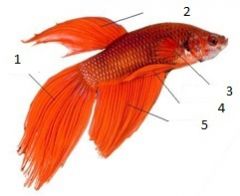
Label the Fish
1. 2. 3. 4. 5. |

1. Caudal FIn
2.Dorsal Fin 3.Pectoral Fin 4.Ventral Fin 5.Anal Fin |
|
|
Do you conclude that agonistic behavior in Siamese fighting fish is an example of this type of behavior? Why or why not?
|
- Yes it is a fixed action pattern, because they think it’s another betta fish, they look for long fins and once initiated they follow through to completion
|
|
|
What is the obvious adaptive advantage of complex agonistic displays that are not followed by damaging fights? Are there advantages that are not so obvious?
|
- Both have a chance
- Maintain gene pool - Everybody survives that’s healthy |
|
|
Name several other animals that demonstrate a strong display that is seldom followed by a damaging fight.
|
-Birds
- bighorn sheep - camilians |
|
|
Name several animals that do engage in damaging fights.
|
-Lions
- dogs - coyotes - giraffes |
|
|
Autotrophic way of Feeding:
|
photosynthetic
|
|
|
Heterotrophic way of feeding
|
depend on others for food
|
|
|
What is primary production?
|
amount of energy stored by autotrophs
|
|
|
Algae
|
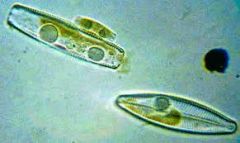
autotrophs protists
Example: diatoms |
|
|
Protozoa
|
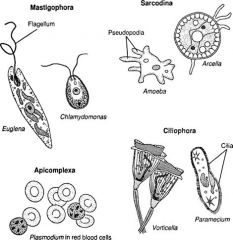
heterotrophic protists
|
|
|
Phagocytosis
|
the uptake of large particles or whole organisms by the pinching inward of the plasma membrane
Example: dog |
|
|
Mixotrophic
|
capable of photosynthesis and ingestion
Example: euglanoids |
|
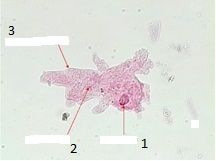
Label the Amoeba
1. 2. 3. |
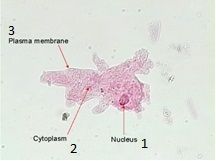
1.Nucleus
2.Cytoplasm 3.plasma membrane |
|
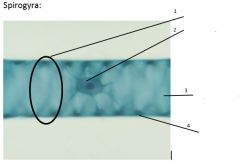
Label the Spirogyra
1. 2. 3. 4. |
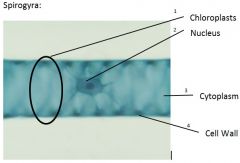
1. Chloroplasts
2.Nucleus 3.Cytoplasm 4.Cell Wall |
|
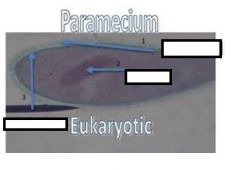
Label the Paramecium
1. 2. 3. |
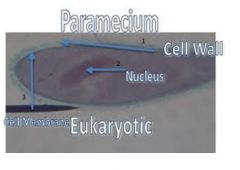
1. Cell Wall
2. Nucleus 3.Cell Membrane |
|
|
How do you think amoeboid organisms with skeletons such as the radiolarians, move food to their cell bodies?
|
- Thread-like pseudopodia
|
|
|
Compare the appearance and rate of locomotion in amoeboid, flagellated and ciliated organisms observed in this exercise.
|
- Amoeboid: lobe-like pseudopods
- Flagellated: whip-like motion - Ciliated: rowing motion |
|
|
Compare dinoflagellates and diatoms. What important ecological role is shared by these two groups?
|
- Primary producers
|
|
|
4. Slime molds were once place in the kingdom fungi. What characteristics suggest that these organisms are protestant?
|
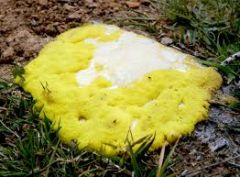
- Phagocytosis
|
|
|
5. What important ecological role is shared by the macroscopic algae (green, red and brown)?
|
- Primary producers
|
|
|
6. What characteristics of green algae have led scientists to conclude that this group includes the ancestors of land plants, most likely the charophytes?
|
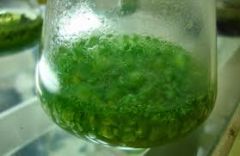
- Photosynthetic
- Cell walls - Chloroplasts |
|
|
Euglenozoans
Example: Trypanosoma Levisi |
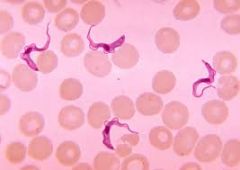
characteristics: Micro Flagellated,parasitic, heterotrophic
Ecological Role: Parasitic Economic Importance: Lives in blood of rats |
|
|
Alveolates
Example: Paramecia |
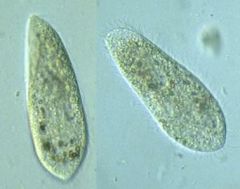
characteristics:Single-celled; Micro
Hetero, alveoli under cell membrane Ecological Role:Food for microscopic consumers in plankton and some animals Economic Importance: Only in role as food for larger organisms |
|
|
Alveolates
Example:Dinoflagellates |
Example:
characteristics:Micro; Single-celled Auto; cell wall in plates Ecological Role: Primary Producer Economic Importance: Secretes Toxins that kill fish in red tides |
|
|
stramenopiles
Example: Diatoms |
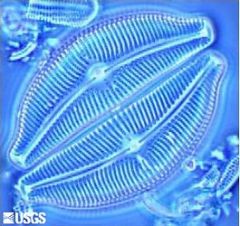
characteristics:Micro; auto; cell wall of silica; pinnate or centric forms
Ecological Role:Primary producer Economic Importance: Diatomaceous earth has commercial uses |
|
|
Rhizarians
Examples: Foraminiferans |

characteristics: Mirco; ameboid; hetero; thread like pseudopodia; secret calcium carbonate tests
Ecological Role: Food for larger organisms in plankton Economic Importance : Form limestone deposits in ocean floor |
|
|
Rhizarians
Examples: Radiolarians |
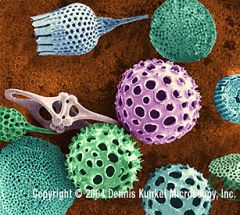
characteristics: Mirco; ameboid; hetero; thread like pseudopodia; secret calcium carbonate tests
Ecological Role: Food for larger organisms in plankton Economic Importance :Form silicon deposits in ocean floor |
|
|
Amoebozoans
Example: Amoeba |
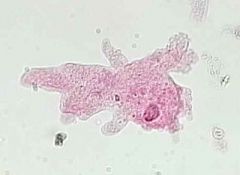
characteristics: Micro; ameboid; lobe-shaped pseudopodia; hetero
Ecological Role: Food for larger organisms Economic Importance :Some may be parasitic |
|
|
Amoebozoans
Example: Physarum |
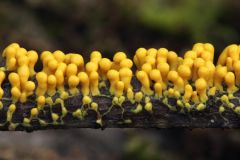
characteristics: Ameboid plasmodium; hetero
Ecological Role: Feeds on bacteria Economic importance : Sold in biological supply houses |
|
|
Chloropyta and Charophyta
Example: Green algae: spirogyra, Ulva, Chara |
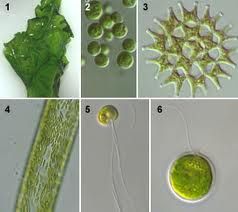
characteristics: Micro and Macro; store amylase; chlorophyll a and b pigments
Ecological Role: Primary producer Economic Importance : Food for humans and livestock and proposed medicinal app. |
|
|
Alternation of generations
|
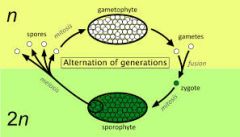
a common sexual reproductive life cycle
|
|
|
Gametophyte
|
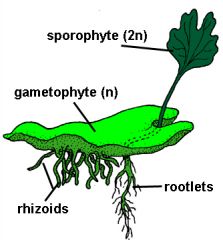
the sexual form of a plant in the alternation of generations
|
|
|
Sporophyte
|
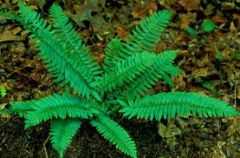
the form of a plant in the alternation of generations that produces asexual spores.
|
|
|
Spores
|
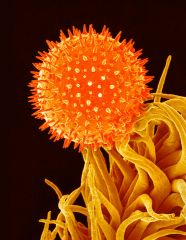
apable of giving rise to a new individual either directly or indirectly.
|
|
|
Sporangium
|
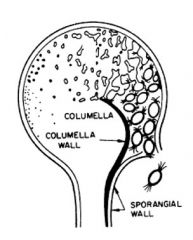
a protective, non-reproductive jacket of cells
|
|
|
Gametes
|
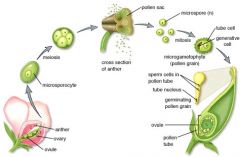
a mature sexual reproductive cell that unites with another cell to form a new organism.
|
|
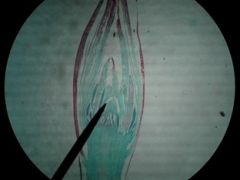
What is this?????
|
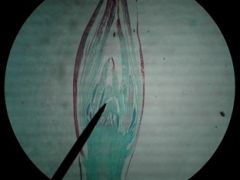
Archegonia of a Moss(female)
|
|

What is this????
|
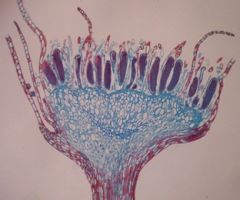
Antheridia of a moss (male)
|
|
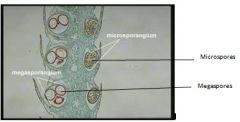
wHAT IS THIS???
|
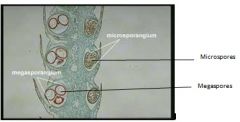
Megasporangia and Microsporangia of Selaginella:
|
|
|
Antheridia
|
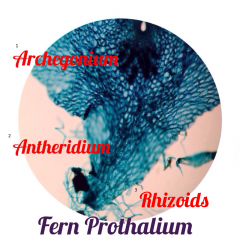
: a male reproductive structure producing gametes, occurring in ferns, mosses, fungi, and algae.
|
|
|
Archegonia
|

the female reproductive organ in ferns, mosses, etc.
|
|
|
GENERAL CHARACTERISICS OF
Bryophytes: |

a) Seedless non-vascular plant
b) Habitat is limited in damp areas c) Gametophyte generation is dominant d) Examples: liverworts, hornworts |
|
|
GENERAL CHARACTERISICS OF
Ferns: |
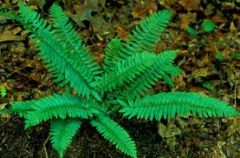
a) Seedless vascular plant
b) Sporophyte generation is dominant c) Habitat is limited in damp areas |
|
|
Are the spores produced by the moss sporophyte formed by meiosis or mitosis? Are they haploid or diploid?
|
- Meiosis/haploid
|
|
|
Do the spores belong to the gametophyte or sporophyte generation?
|
- Sporophyte
|
|
|
Are the gametes haploid or diploid? Are they produced by meiosis or mitosis?
|
- Haploid/mitosis
|
|
|
Is the dominant generation for the mosses the gametophyte or the sporophyte?
|
- Gametophyte
|
|
|
Can you suggest any ecological role for mosses?
|
- Primary producers
|
|
|
What feature of the life cycle differs for bryophytes compared with all other land plants?
|
- Gametophyte generation is dominant
|
|
|
Are these leafy plants part of the sporophyte or the gametophyte generation? Do you have any evidence to support your answer?
|
- Sporophyte: if mega or micro sporangium is present then it’s a sporophyte
|
|
|
What features would you look for to determine if this were a seedless vascular plant?
|
- If it has spores
|
|
|
Are the microspores and megaspores produced by mitosis or meiosis?
|
- Meiosis
|
|
|
Will megaspores divide to form the female gametophyte or the sporophyte?
|
- Gametophyte
|
|
|
Are the spores produced by the fern sporophyte formed by meiosis or mitosis?
|
- Meiosis
|
|
|
Do the spores belong to the gametophyte or the sporophyte generation?
|
- Sporophyte
|
|
|
Are the gametes produced by meiosis or mitosis?
|
- Meiosis
|
|
|
Are the archegonia and antheridia haploid or diploid? This about which generation produces them.
|
- Haploid: gametophyte generation
|
|
|
15. Is the dominant generation for the fern the gametophyte or the sporophyte?
|
- Sporophyte
|
|
|
Can you suggest en ecological role for ferns?
|
- Primary producers
|
|
|
Do you think that non-vascular plants could ever have been large sized plants?
|
- No because they don’t have vascular tissue
|
|
|
What is the significance of chemotaxis to fern reproduction?
|
- So the sperm can find the egg
|
|
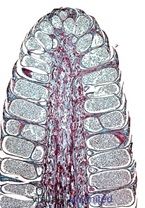
What is this?
|
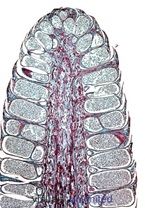
Staminate cone
|
|
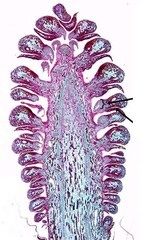
What is this????
|
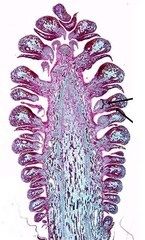
Ovulate cone
|
|
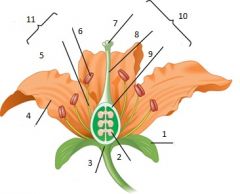
Label the Flower:
1-11 |
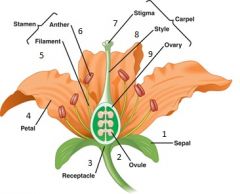
1. Sepal
2. Ovule 3.Receptacle 4. Pedal 5. Filament 6. Anther 7. Stigma 8.Style 9.Ovary 10.Carpel 11.Stamen |
|
|
What is the function of the wings on the pollen grain?
|
- Wind dispersal
|
|
|
Why is wind dispersal an important phenomenon in the evolution of plants?
|
- No longer need water for reproduction
|
|
|
Are microspores and megaspores produced by mitosis or meiosis?
|
- Meiosis
|
|
|
Can you think of at least two ways in which pine seeds are dispersed?
|
- Wind
- Animals |
|
|
Plants have evolved a number of characteristics that attract animals and ensure pollination, but what are the benefits to animals in this relationship?
|
- Fruit and nutrition
|
|
|
6. Why is internal fertilization essential for true terrestrial living?
|
- Protection against water
|
|
|
7. Explain how the rise in prominence of one major group does not necessarily result in the total replacement of a previously dominant group?
|
- They have different habitats
|
|
|
What is the problem with your neighbors rose garden?
|
- She killed the pollinators
|
|
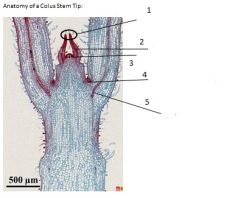
Label the Anatomy of a Colus Stem Tip
1-5 |
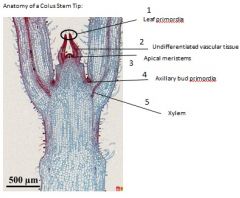
1. Leaf Primordia
2 Undifferentiated vascular tissue 3. Apical meristems 4. Axillary bud primordia 5.Xylem |
|
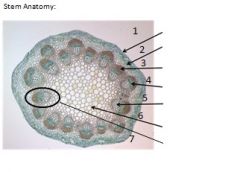
Name the Stem Anatomy
1-7 |
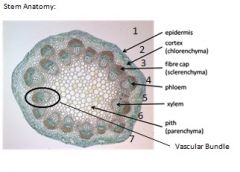
1. Epidermis
2. Cortex (choenchyma ) 3. Fibre Cap (slerenchyma) 4.,Phloem 5.Xylem 6.Pith (parenchyma) 7. Vascular Bundle |
|
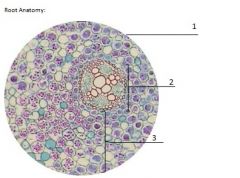
Label the Root Anatomy
1-3 |
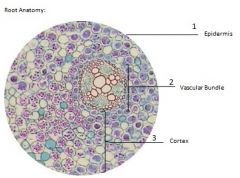
1. Epidermis
2. Vascular Bundle 3.Cortex |
|
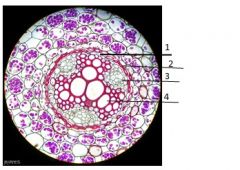
Label More Root Anatomy
1-4 |
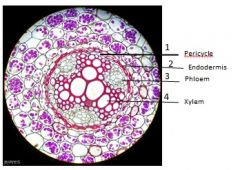
1. Pericycle
2. Endodermis 3. Phloem 4. Xylem |
|

Label the Root
1-7 |

1.Root Cap
2. Root Tip ( Longitudainal Section) 3. Zone of Cell Division 4. Zone of Elongation 5.Zone of Maturation 6. Epidermis Root Hair 7. Vascular Cylinder |
|

Label the Leaf Anatomy
1-6 |
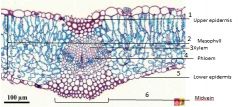
1. Upper Epidermis
2. Mesophyll 3. Xylem 4. Phloem 5. Lower Epidermis 6.Midvein |
|
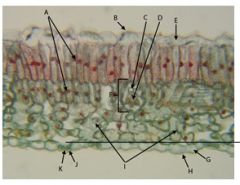
Label the Leaf
A-K |
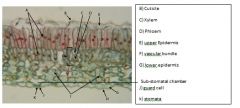
A)
B) Cuticle C) Xylem D) Phloem E) upper Epidermis F) vascular bundle G) lower epidermis J) guard cell k) stomata |
|
|
Which are larger and more distinct, xylem cells or phloem cells?
|
- Xylem
|
|
|
What is the function of the xylem and phloem?
|
- Xylem: transports water and minerals from the roots to leaves
- Phloem: transports nutrients from the leaves to roots |
|
|
Suggest that the advantage of taproots and of fibrous roots under different environmental conditions
|
- Taproots: desert, because they have to ravel deeper down to find water
- Fibrous: moist areas, because in moist areas water stays at the surface |
|
|
Compare the structure and organization of roots and stems. How do these two organs differ?
|
- Roots: absorbs water and nutrients
- Stems: transports nutrients up and down |
|
|
Note that the epidermis of the root lacks a cuticle. Can you explain why this might be advantageous?
|
- Prevents desiccation
- Strong need to absorb water |
|
|
Describe the functions of leaves
|
- Photosynthesis
|
|
|
Provide evidence from your observations of leaf structure to support the hypothesis that structure and function be related. Be specific in your examples.
|
- Wide, flat, lots of surface area
- Leaves are widely spread - Green - Stomata |
|
|
8. Explain the observation that more stomata are found on the lower surface of the leaf than on the upper.
|
- Keeps it from drying out
|
|
|
What has happened to the several years of phloem tissue production?
|
- Phloem gets pushed outside
|
|
|
Based on your observations of the woody stem, does xylem or phloem provide structural support for trees?
|
- Xylem
|
|
|
Cells of the epidermis frequently retain a capability for cell division. Why is this important?
|
- Protect against damage
|
|
|
Why is the endodermis essential in the root but not in the stem?
|
- To filter everything it absorbs
|
|
|
Using your knowledge of the dual functions of guard cells relative to water retention and uptake of carbon dioxide, explain the reduction in photosynthetic productivity.
|
- Guard cells closed, stops intake of CO2 and water
|
|
|
Hypothesize about the trends in stomatal density that might be expected in response to climate change and increased carbon dioxide concentration.
|
- Decrease number of stomata as CO2 increase
|
|
|
The belt buckle of a standing 20 year old man may be a foot higher that it was when he was 10, but a nail driven into a 10 year old tree will be at the same height 10 years later. Explain.
|
- Because a tree grows from the top up
|
|
|
What special feature of plants provides for this incredible longevity? How do plants differ from animals in their pattern of growth and development?
|
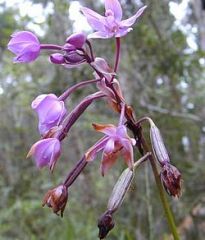
- Some plants have indeterminate growth
- Animals have determinate growth |
|
|
Hyphae
|
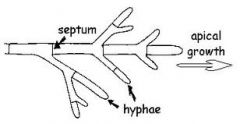
threadlike individual filaments
|
|
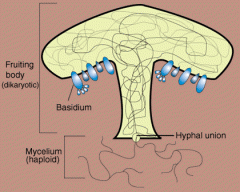
Mycelium
|
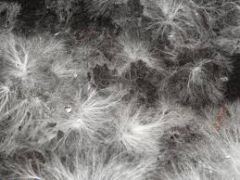
organs organized into the body of the fungus
|
|
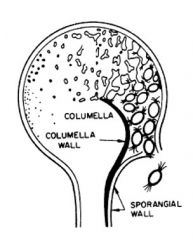
Sporangia
|
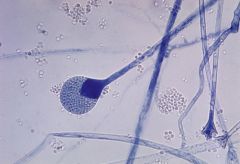
round structures that hold spores
|
|
|
Ascocarp
|
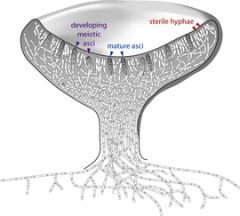
a closed spherical structure that develops a pore at the top for spore dispersal.
|
|
|
Conidia:
|
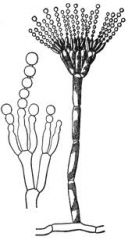
spores
|
|
|
Phylum:
Zygomycota (zygote fungi |
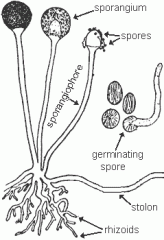
examples: rhizopus
Sexual reproductive structures: Zygote sporangia produce spores Asexual reproductive structures: Sporangia and spores |
|
|
Phylum:
Ascomycota (sac fungi) |
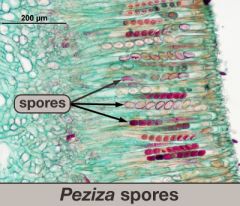
examples: Peziza penicillium
Sexual reproductive structures: Ascocarp ascospores Asexual reproductive structures: conidia |
|
|
Phylum:
Basidiomycota (club fungi) |
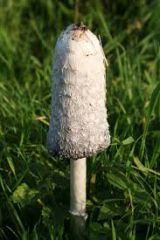
examples: Coprinus
Sexual reproductive structures: Pseudocarp pseudio spores Asexual reproductive structures: Conidia |
|
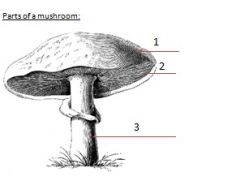
Label the Parts of a Mushroom
1-3 |
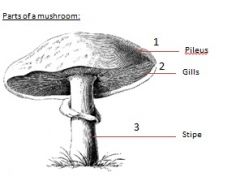
1. Pileus
2. Gills 3. Stipe |
|
|
Know the symbiotic relationships of lichens
|
- The fungus of lichens has a mutualistic symbiotic relationship with algae. The fungi provide protection and moisture to the algae, and the algae feed the fungi with photosynthetic nutrients.
|
|
|
Imagine an ecosystem with no fungi. How would it be modified?
|
- Breaking down death and decaying nutrients
- Mutualistic provide nutrients - Recycle nutrients |
|
|
Speculate about a possible evolutionary advantage to the fungus for the following:
|
A) Penicillium makes and secretes an antibiotic
- Reduces competition B) Ergto fungus produces a chemical that is toxic to animals. - Prevents it from being eaten by animals - Reduces competition |
|
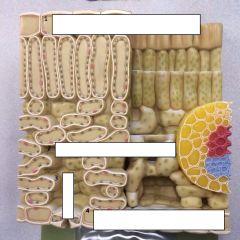
Fill in the blanks
|
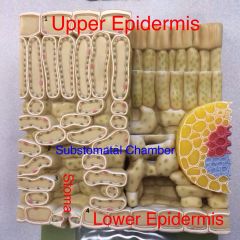
here
|
|
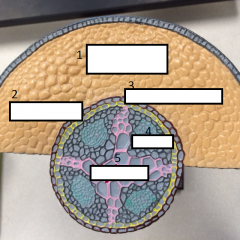
Fill in the blanks
|
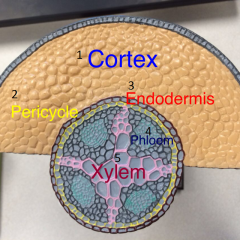
here
|
|

label
|

here
|

